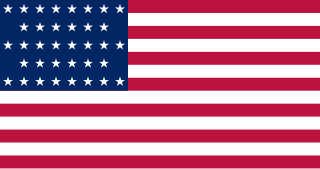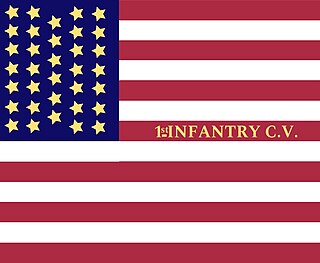
California's involvement in the American Civil War included sending gold east to support the war effort, recruiting volunteer combat units to replace regular U.S. Army units sent east, in the area west of the Rocky Mountains, maintaining and building numerous camps and fortifications, suppressing secessionist activity and securing the New Mexico Territory against the Confederacy. The State of California did not send its units east, but many citizens traveled east and joined the Union Army there, some of whom became famous.

The First Regiment Oregon volunteer Cavalry was a volunteer regiment in United States service Union army that was formed in response to the American Civil War. With men recruited in Oregon and some recruited in surrounding states, the regiment primarily served to protect the state of Oregon and surrounding territories during the American Civil War.

The 4th California Infantry was a volunteer infantry regiment recruited from northern California during the American Civil War. It was organized at Sacramento, Placerville, and Auburn in September and October 1861.

The 1st Regiment California Volunteer Infantry was an infantry regiment in the Union Army during the American Civil War. It spent its entire term of service in the western United States.
Galvanized Yankees was a term from the American Civil War denoting former Confederate prisoners of war who swore allegiance to the United States and joined the Union Army. Approximately 5,600 former Confederate soldiers enlisted in the United States Volunteers, organized into six regiments of infantry between January 1864 and November 1866. Of those, more than 250 had begun their service as Union soldiers, were captured in battle, then enlisted in prison to join a regiment of the Confederate States Army. They surrendered to Union forces in December 1864 and were held by the United States as deserters, but were saved from prosecution by being enlisted in the 5th and 6th U.S. Volunteers. An additional 800 former Confederates served in volunteer regiments raised by the states, forming ten companies. Four of those companies saw combat in the Western Theater against the Confederate Army, two served on the western frontier, and one became an independent company of U.S. Volunteers, serving in Minnesota.

The 1st Regiment of Washington Territory Volunteer Infantry was a unit of infantry raised by the Washington Territory for service in the Union Army during the American Civil War.

The 2nd Regiment California Volunteer Cavalry was a cavalry regiment in the Union Army during the American Civil War. It spent its entire term of service in the western United States, with most of its companies dispersed to various posts.
Fort Gaston was founded on December 4, 1859, in the redwood forests of the Hoopa Valley, in Northern California, on the west bank of the Trinity River, 14 miles (23 km) from where the Trinity flows into the Klamath River. It was located in what is now the Hoopa Valley Indian Reservation. Fort Gaston as part of the Humboldt Military District was intended to control the Hupa Indians and to protect them from hostile white settlers. The post was named for 2nd Lieutenant William Gaston, of the First Dragoons, who had been killed May 17, 1858, during the Spokane–Coeur d'Alene–Paloos War.
Daniel Showalter (1830–1866), was a California miner, state legislator, duelist, secessionist, and Confederate States of America military officer in Texas.

The District of Southern California was a 19th-century district of Department of the Pacific, a command of the United States Army.

The 3rd Regiment California Volunteer Infantry was an infantry regiment in the Union Army during the American Civil War. This regiment was organized at Stockton and at Benicia Barracks, from October 31 to December 31, 1861, to serve three years. The regiment was first commanded by Colonel Patrick Edward Connor. After the formation of the regiment at Stockton, four companies were sent to Humboldt County during the month of November, 1861. During the month of July, 1862, Colonel Connor was sent, with his regiment, to the District of Utah, in which it was on duty for the balance of its term of service.

The 2nd Regiment California Volunteer Infantry was an infantry regiment in the Union Army during the American Civil War. It spent its entire term of service in the western United States. Organized at San Francisco and Carson City September 2, 1861, to December 30, 1862, and attached to Department of the Pacific. The regiment was first assembled at the Presidio, San Francisco, and after completing its organization, five companies were sent to Oregon and Washington Territory, to relieve the regular troops, and two companies were sent to Santa Barbara. The troops of this regiment sent to Oregon were afterwards returned to California. It was mustered out during the month of October, 1864.
The 1st Battalion of Native Cavalry, California Volunteers was a cavalry battalion in the Union Army during the American Civil War. Recruits were largely drawn from the Californio population, though its ranks included Yaqui and Mission Indians as well as immigrants from Mexico, Hispano America and Europe. In addition to its ethnic makeup, the Battalion is also considered unusual for being one of the few lancer units in the United States Army.

The 5th Regiment California Volunteer Infantry was an infantry regiment in the Union Army during the American Civil War. It spent its entire term of service in the western United States, attached to the Department of the Pacific and Department of New Mexico.
The Department of New Mexico was a department of the United States Army during the mid-19th century. It was created as the 9th Department, a geographical department, in 1848 following the successful conclusion of the Mexican–American War, and renamed Department of New Mexico in 1853. It had to contend with an invading Confederate force during the New Mexico Campaign of the American Civil War from mid-1861 to early 1862, then with Apache tribes during the remainder of the conflict. It was merged into the Department of California after the end of the war as the District of New Mexico.
The 6th Regiment California Volunteer Infantry was an infantry regiment in the Union Army during the American Civil War. It spent its entire term of service in the western United States attached to the Department of the Pacific. The Regiment was organized at Benicia Barracks, San Francisco on February 1, 1863. 6th Regiment mustered out from October 25 to December 20, 1865. The only recorded engagements of the Regiment occurred with the detachment sent to the Humboldt Military District in 1864, near the end of the Bald Hills War. It had engagements with the Indians in the Skirmish at Booth's Run, May 1 and Kneeland's Prairie May 2, near Boynton's Prairie May 6 and at Grouse Creek May 23.

Clarence Edmund Bennett (1833–1902), usually referred to as Clarence E. Bennett, a graduate of West Point, a career American Army officer who saw duty almost exclusively in Western frontier assignments, served in the American Civil War in California, New Mexico and Arizona Territories and later in Reconstruction occupation forces and frontier duty during the later Indian Wars.
Hispanics in the American Civil War fought on both the Union and Confederate sides of the conflict. Not all the Hispanics who fought in the American Civil War were "Hispanic Americans" — in other words citizens of the United States. Many of them were Spanish subjects or nationals from countries in the Caribbean, Central and South America. Some were born in what later became a U.S. territory and therefore did not have the right to U.S. citizenship. It is estimated that approximately 3,500 Hispanics, mostly Mexican-Americans, Puerto Ricans and Cubans living in the United States joined the war: 2,500 for the Confederacy and 1,000 for the Union. This number increased to 10,000 by the end of the war.
Louis Henry Marshall (1827–1891) was a native of Virginia, a U. S. Army officer on the frontier in the Antebellum Period, in the American Civil War and in the Snake War.







